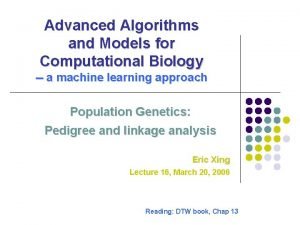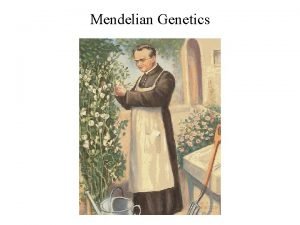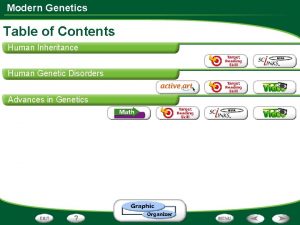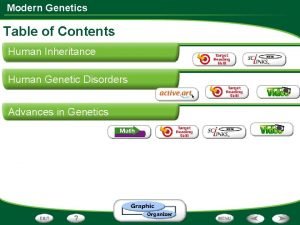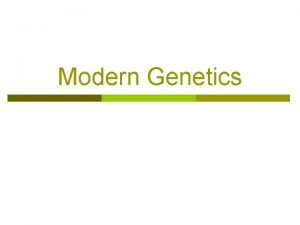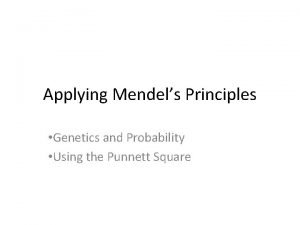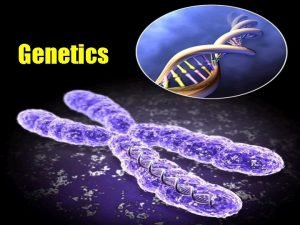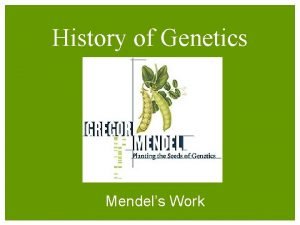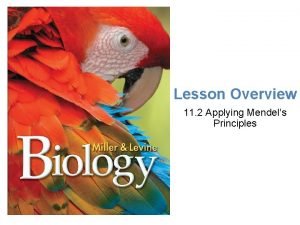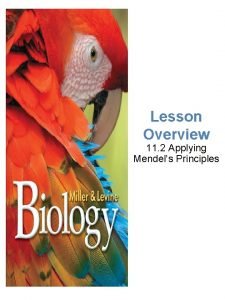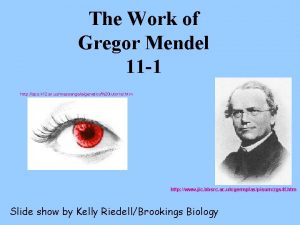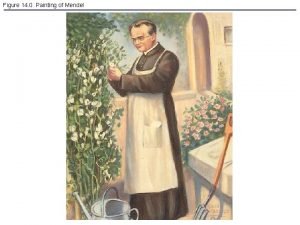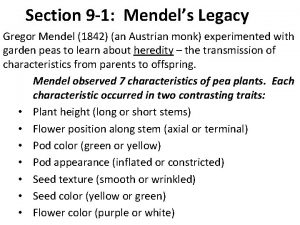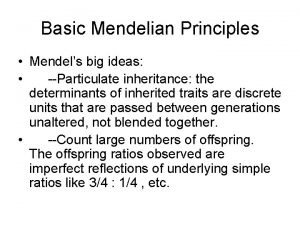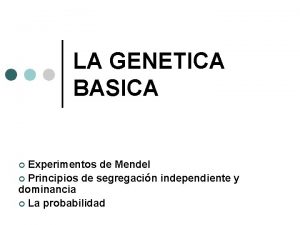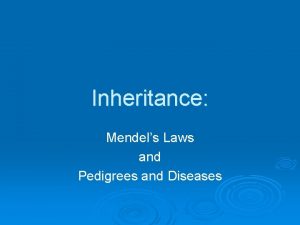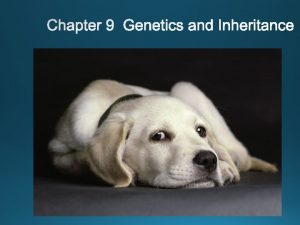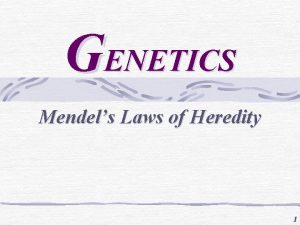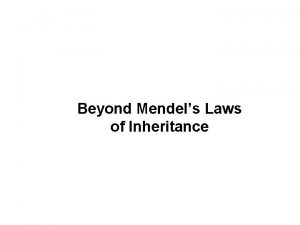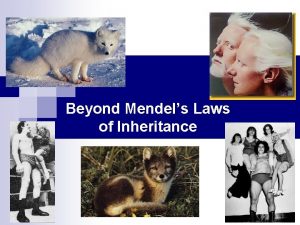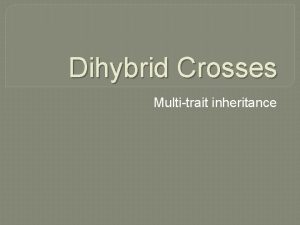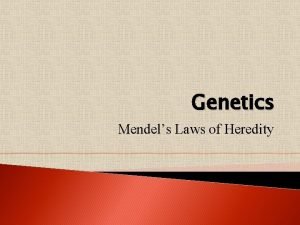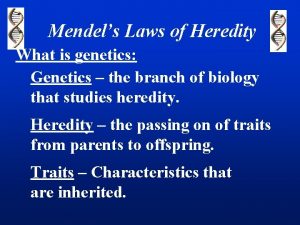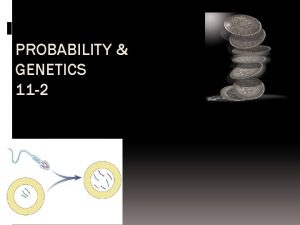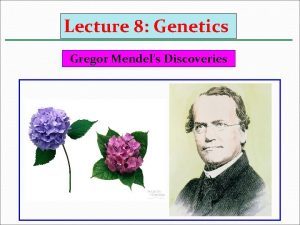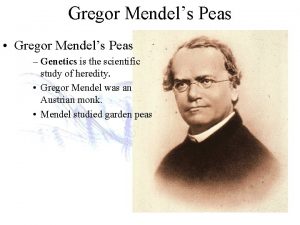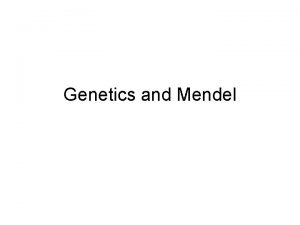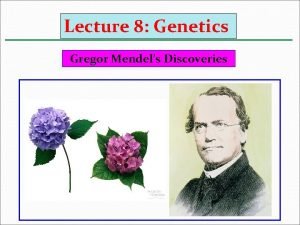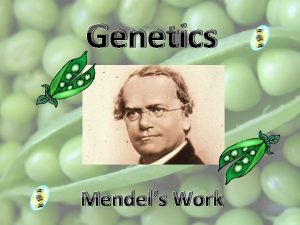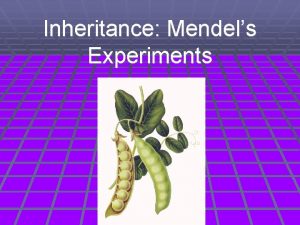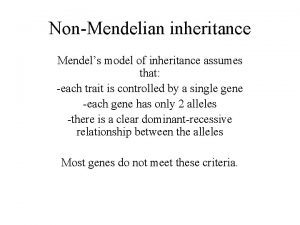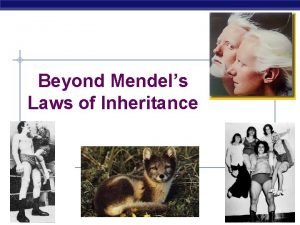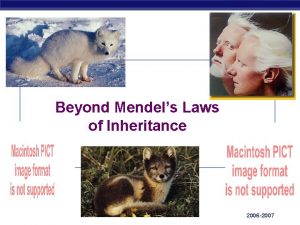Genetics Mendels Laws of Inheritance Genetics Genetics is






















- Slides: 22

Genetics Mendel’s Laws of Inheritance

Genetics • Genetics is the study of heredity. • Traits are controlled through genes, which are found on chromosomes. • Different forms of a gene are called alleles.

Gregor Johann Mendel §Called the “Father of Genetics" §Between 1856 and 1863, Mendel cultivated and tested some 28, 000 pea plants §He found that the plants' offspring retained traits of the parents copyright cmassengale 3

Why Peas? §Can be grown in a small area §Produce lots of offspring §Produce pure plants when allowed to selfpollinate several generations §Can be artificially cross-pollinated copyright cmassengale 4

Reproduction in Flowering Plants • Pollen contains sperm –Produced by the stamen • Ovary contains eggs –Found inside the flower Pollen carries sperm to the eggs for fertilization Self-fertilization can occur in the same flower Cross-fertilization can occur between flowers copyright cmassengale 5

Mendel’s Experimental Methods • Mendel hand-pollinated flowers using a paintbrush –He could snip the stamens to prevent selfpollination –Covered each flower with a cloth bag • He traced traits through the several generations copyright cmassengale 6

How Mendel Began Mendel produced pure strains by allowing the plants to selfpollinate for several generations copyright cmassengale 7

copyright cmassengale 8

copyright cmassengale 9

Mendel’s Experimental Results copyright cmassengale 10

Generation “Gap” • Parental P 1 Generation = the parent generation. (Ex: Your Grandparents) • F 1 generation = the first-generation offspring (Ex: Your Parents) – From breeding individuals from the P 1 generation • F 2 generation = the secondgeneration offspring (Ex: You) – From breeding individuals from the F 1 generation copyright cmassengale 11

Following the Generations Cross 2 Pure Plants TT x tt Results in all Hybrids Tt Cross 2 Hybrids get 3 Tall & 1 Short TT, Tt, tt copyright cmassengale 12

Mendel’s Principles 1. 2. 3. 4. Genes in Pairs Law of Dominance Law of Segregation Law of Independent Assortment

Genes In Pairs • Genetic characteristics are controlled by genes that exist in pairs of alleles in individual organisms • These alleles are passed from parents to their offspring. • When two organisms produce offspring, each parent gives the offspring one copy of each allele. • Offspring will have 2 copies of each allele, one from each parent.

Law of Dominance • When two unlike alleles responsible for a single characteristic are present in a single individual, one allele can mask the expression of another allele. • The allele that is expressed (shows up) is dominant to the other. • The allele that is masked (does not show) is said to be recessive.

Law of Segregation • Occurs during Meiosis • During the formation of gametes, the paired alleles separate (segregate) randomly so that each gamete receives one allele or the other. • This ensures that each gamete will recieve 1 copy of each gene.

Law of Independent Assortment • Occurs during Meiosis • During gamete formation, segregating pairs of alleles assort independently of each other. Ex: genes on different chromosomes will segregate independently. • This ensures that each gamete will get a mixture of genes from both of the individual’s parents. • Linked genes (close together on one chromosome) do not follow this law.

Important Terminology Allele Dominant & Recessive Homozygous & Heterozygous Phenotype & Genotype

Dominant/Recessive • Some alleles are dominant; represented by a capital letter; ex. Tall = T • Some alleles are recessive; represented by lower case letter; ex. Short = t • If the dominant allele is present, it will mask the recessive allele. Ex: Tt = Tall

Homozygous/Heterozygous • Homozygous— “same gamete; ” 2 identical alleles – Homozygous dominant = TT – Homozygous recessive = tt • Heterozygous— “different gamete; ” 2 different alleles; Tt

Phenotype/Genotype • Phenotype = physical characteristics – ex: Tall or Short • Genotype = actual genetic make-up – ex: TT or Tt or tt

Punnett Squares • Tool used to determine the probability that a trait will be transmitted. • Punnett Squares do NOT show ACTUAL results of a cross.
 3 laws of inheritance
3 laws of inheritance Mendels two laws
Mendels two laws Mendels laws
Mendels laws In the punnett square shown in figure 11-1
In the punnett square shown in figure 11-1 Probability laws govern mendelian inheritance
Probability laws govern mendelian inheritance Human inheritance modern genetics answer key
Human inheritance modern genetics answer key Modern genetics human inheritance answer key
Modern genetics human inheritance answer key Modern genetics human inheritance answer key
Modern genetics human inheritance answer key Charles de secondat
Charles de secondat Applying mendels principles
Applying mendels principles Mendels law of segregation states that
Mendels law of segregation states that Mendels
Mendels Chapter 12 lesson 2 applying mendels principles
Chapter 12 lesson 2 applying mendels principles Chapter 12 lesson 2 applying mendels principles
Chapter 12 lesson 2 applying mendels principles Mendels sps
Mendels sps Mendel
Mendel Section 9-1 mendels legacy
Section 9-1 mendels legacy Mendels fabric
Mendels fabric Cruce entre vvrr x vvrr
Cruce entre vvrr x vvrr Gregor mendel mbti
Gregor mendel mbti 11.2 applying mendel's principles
11.2 applying mendel's principles Who was mendal
Who was mendal Phenotype and genotype
Phenotype and genotype

